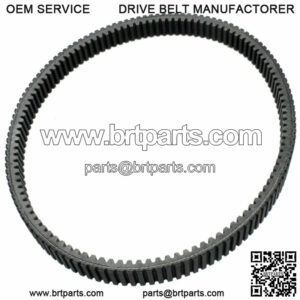In a snowmobile, the drive belt plays a crucial role in transmitting power from the engine to the track, enabling the vehicle to move forward. It is an essential part of the snowmobile’s propulsion system and is sometimes referred to as the “track drive belt” or “clutch belt.”
The drive belt is a flexible, reinforced rubber belt with cogs or teeth on the inner side. It connects the primary clutch (drive clutch) on the engine to the secondary clutch (driven clutch) on the driveshaft or jackshaft. Here’s how the drive belt functions in a snowmobile:
- Power transmission: When the engine runs, the primary clutch spins with it. The drive belt wraps around the primary clutch and moves with it due to the rotation. As the primary clutch spins, the cogs on the inner side of the belt mesh with the corresponding grooves on the primary clutch, effectively transferring power to the drive belt.
- Clutch engagement: The primary clutch is designed to vary its diameter based on engine RPM (revolutions per minute). As the engine speed increases, the primary clutch’s diameter changes, causing the drive belt to move higher or lower on the primary clutch sheaves. This process is known as clutch engagement or clutch shifting.
- Speed variation: As the drive belt moves on the primary clutch, it changes the effective diameter of the secondary clutch, altering the gear ratio of the snowmobile’s transmission. This speed variation allows the snowmobile to achieve different speeds and torque levels efficiently, depending on the terrain and driving conditions.
- Track propulsion: The secondary clutch is connected to the driveshaft or jackshaft, which, in turn, drives the track of the snowmobile. As the engine’s power is transmitted through the drive belt and the clutch system, the track starts to move, propelling the snowmobile forward.
Proper maintenance of the drive belt is essential to ensure optimal performance and prevent breakdowns. Regular inspection, cleaning, and replacement of worn-out drive belts are recommended to avoid unexpected failures and ensure safe and reliable snowmobiling experiences. Additionally, ensuring the proper tension of the belt and maintaining the clutch system will help preserve the longevity of the drive belt and overall snowmobile drivetrain.
About Snowmobile Drive Belt
how to remove snowmobile drive belt
best snowmobile drive belt
snowmobile drive belt alignment
ski-doo drive belt application chart
polaris snowmobile drive belt adjustment
how a snowmobile drive belt works
what is a snowmobile drive belt

